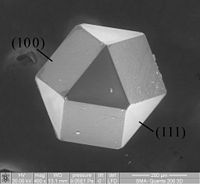
Photo from wikipedia
Oxygen evolution reactions (OERs) are regarded as the rate-determining step of electrocatalytic overall water splitting, which endow OER electrocatalysts with the advantages of high activity, low cost, good conductivity, and… Click to show full abstract
Oxygen evolution reactions (OERs) are regarded as the rate-determining step of electrocatalytic overall water splitting, which endow OER electrocatalysts with the advantages of high activity, low cost, good conductivity, and excellent stability. Herein, a facile H2O2-assisted etching method is proposed for the fabrication of Mo-doped ultrathin Co9Se8@NiSe/NF-X heterojunctions with rich Se vacancies to boost electrocatalytic water oxidation. After step-by-step electronic structure modulation by Mo doping and Se vacancy engineering, the self-standing Mo-Co9Se8@NiSe/NF-60 heterojunctions deliver a current density of 50 mA cm-2 with an overpotential of 343 mV and a cell voltage of only 1.87 V at 50 mA cm-2 for overall water splitting in 1.0 M KOH. Our study opens up the possibility of realizing step-by-step electronic structure modulation of nonprecious OER electrocatalysts via heteroatom doping and vacancy engineering.
Journal Title: Nanoscale
Year Published: 2022
Link to full text (if available)
Share on Social Media: Sign Up to like & get
recommendations!